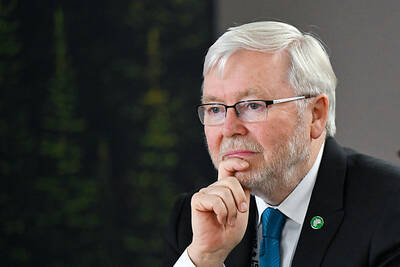A sharp fall in the Australian dollar may provide a short-term boost to economic growth, but also risks re-igniting inflationary fears in the longer term, dealers say.
The Aussie dollar has slumped almost 20 percent since reaching a 25-year high of US$0.9849 in mid-July, when many economists predicted it would reach parity with the greenback for the first time since it was floated in 1983.
But falling commodity prices and Australia’s first interest rate cut in almost seven years this month saw the currency slip below US$0.80 for the first time in 13 months last week.
While it recovered slightly to close at US$0.8063 on Friday, market watchers said the currency was likely to fall further amid expectations that the Reserve Bank of Australia (RBA) would again cut rates to offset an economic slowdown.
“With commodity prices still falling, further interest rate cuts likely from the RBA ... further falls in the Australian dollar are likely over the next six months or so, with next stop being around 75 US cents,” AMP Capital Investors chief economist Shane Oliver said.
The declining currency is tipped to significantly impact on Australia’s trade sector.
“While this may provide a short-term boost to the economy via the terms of trade, it also creates upside risks to the outlook for tradeables inflation,” said Warren Hogan, ANZ Bank’s head of Australian economics and interest rate research.
He said a weaker currency would affect the terms of trade — the ratio of export to import prices — by making exports cheaper to overseas customers and imports more expensive for Australian consumers.
“This should be a positive for net exports and for overall GDP growth,” Hogan said.
The longer-term problem stems from what Hogan terms “tradeables inflation,” when the cost of living in Australia rises because of the higher prices consumers have to pay for imported goods.
The threat from rising inflation was the major reason the Reserve Bank hiked Australian interest rates to among the highest in the developed world before this month’s policy reversal in the face of slowing growth.
Any indications that inflationary pressures were on the rise were likely to make the central bank more cautious about further interest rate cuts, Hogan said.
The bank has predicted headline inflation will hit 5 percent next year, but says it is then likely to return to the official target rate of 2 percent to 3 percent if wage and demand growth remain moderate in the near term.

NEXT GENERATION: The four plants in the Central Taiwan Science Park, designated Fab 25, would consist of four 1.4-nanometer wafer manufacturing plants, TSMC said Taiwan Semiconductor Manufacturing Co (TSMC, 台積電) plans to begin construction of four new plants later this year, with the aim to officially launch production of 2-nanometer semiconductor wafers by late 2028, Central Taiwan Science Park Bureau director-general Hsu Maw-shin (許茂新) said. Hsu made the announcement at an event on Friday evening celebrating the Central Taiwan Science Park’s 22nd anniversary. The second phase of the park’s expansion would commence with the initial construction of water detention ponds and other structures aimed at soil and water conservation, Hsu said. TSMC has officially leased the land, with the Central Taiwan Science Park having handed over the

AUKUS: The Australian Ambassador to the US said his country is working with the Pentagon and he is confident that submarine issues will be resolved Australian Ambassador to the US Kevin Rudd on Friday said that if Taiwan were to fall to China’s occupation, it would unleash China’s military capacities and capabilities more broadly. He also said his country is working with the Pentagon on the US Department of Defense’s review of the AUKUS submarine project and is confident that all issues raised will be resolved. Rudd, who served as Australian prime minister from 2007 to 2010 and for three months in 2013, made the remarks at the Aspen Security Forum in Colorado and stressed the longstanding US-Australia alliance and his close relationship with the US Undersecretary

‘WORLD WAR III’: Republican Representative Marjorie Taylor Greene said the aid would inflame tensions, but her amendment was rejected 421 votes against six The US House of Representatives on Friday passed the Department of Defense Appropriations Act for fiscal 2026, which includes US$500 million for Taiwan. The bill, which totals US$831.5 billion in discretionary spending, passed in a 221-209 vote. According to the bill, the funds for Taiwan would be administered by the US Defense Security Cooperation Agency and would remain available through Sept. 30, 2027, for the Taiwan Security Cooperation Initiative. The legislation authorizes the US Secretary of Defense, with the agreement of the US Secretary of State, to use the funds to assist Taiwan in procuring defense articles and services, and military training. Republican Representative

TAIWAN IS TAIWAN: US Representative Tom Tiffany said the amendment was not controversial, as ‘Taiwan is not — nor has it ever been — part of Communist China’ The US House of Representatives on Friday passed an amendment banning the US Department of Defense from creating, buying or displaying any map that shows Taiwan as part of the People’s Republic of China (PRC). The “Honest Maps” amendment was approved in a voice vote on Friday as part of the Department of Defense Appropriations Act for the 2026 fiscal year. The amendment prohibits using any funds from the act to create, buy or display maps that show Taiwan, Kinmen, Matsu, Penghu, Wuciou (烏坵), Green Island (綠島) or Orchid Island (Lanyu, 蘭嶼) as part of the PRC. The act includes US$831.5 billion in